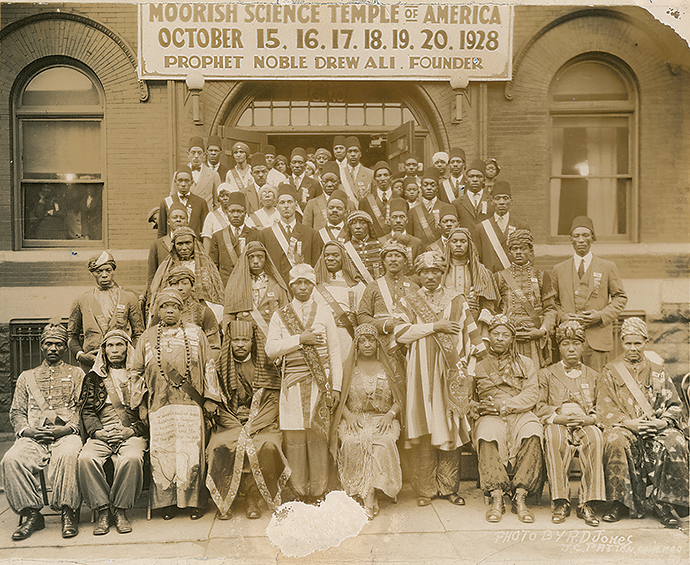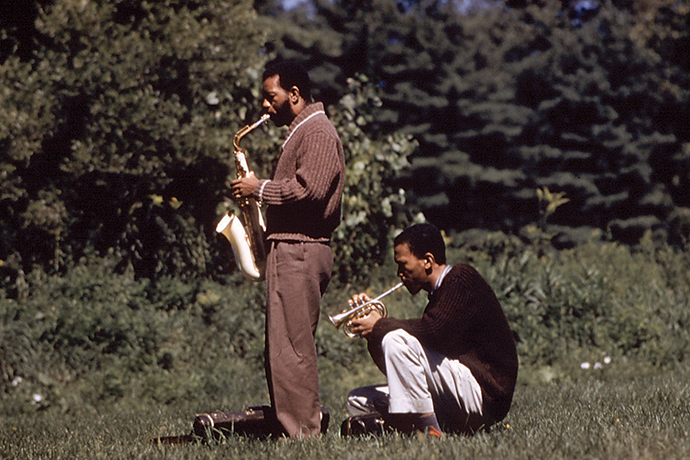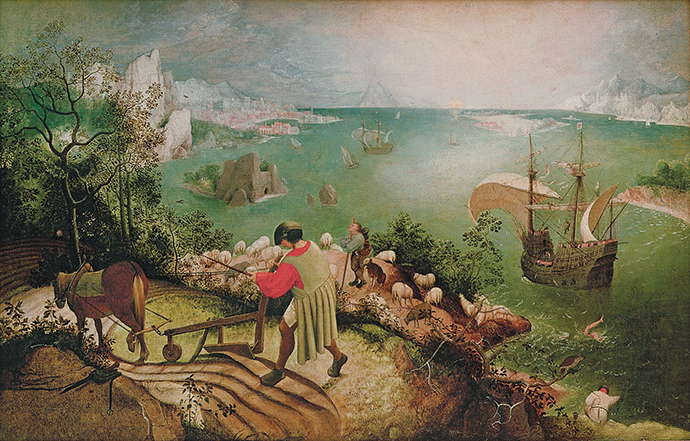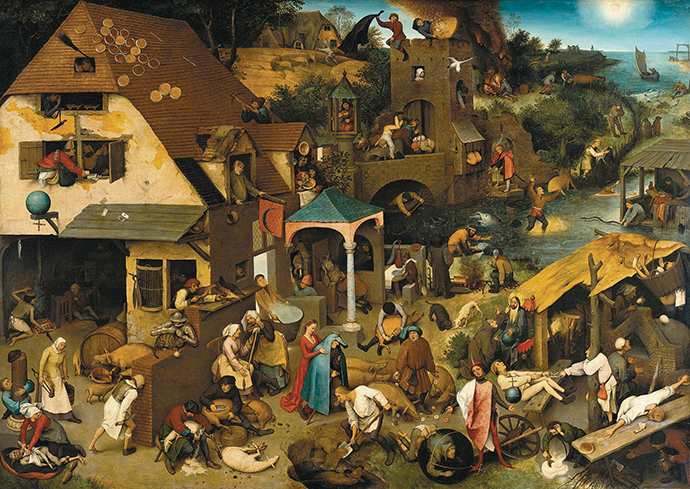
Members of the Moorish Science Temple of America at an annual gathering, 1928 Courtesy Schomburg Center for Research in Black Culture, the New York Public Library
Last summer, Philadelphia proclaimed July 15 a day in honor of Moroccan Americans. The mayor’s office held a flag-raising ceremony at city hall, where a municipal official, flanked by men in red fezzes, praised the contributions of immigrants to civic life. “We are the Moors!” chanted the small crowd, which, according to Morocco World News, did not include a single Moroccan. Rather, the honorees belonged to the Moorish Science Temple of America (MSTA), a religious movement established by the Jazz Age street-corner preacher Noble Drew Ali. Although they could be described as African-American Muslims, Moors self-identify as “Asiatic,” claiming that George Washington destroyed evidence of their Moroccan nationality. Their scripture, the Circle Seven Koran, does not include a single saying of the Prophet Mohammed. Yet, without Moorish Science, there might never have been a Muhammad Ali or Malcolm X.
In The Princess and the Prophet (Beacon Press, $29.95), Jacob S. Dorman explains how Moorish Science became the first Islamic mass movement in the United States. The story is, to put it lightly, a trip. Noble Drew Ali first won converts in mid-1920s Chicago, where he performed escape magic, wholesaled root powders, and cobbled together a holy book, mostly by plagiarizing Christian esoterica. Preaching an Orientalized gospel of racial uplift, he appealed to black Chicagoans tired of discrimination and anxious to distance themselves from the stereotyped masses of moonshine-swilling, pig’s-feet-eating Southerners of the Great Migration. The new religion’s trappings were exotic, but its doctrine was downright respectable: patriotism, sobriety, economic advancement, and the cardinal virtues of “love, truth, peace, freedom, and justice.”
Drew Ali’s success was deeply entwined with Prohibition-era Chicago’s fantastically corrupt Republican machine. Bankrolled by Samuel “Emperor” Insull, an electricity baron and Thomas Edison protégé who once considered hiring Al Capone for corporate security, the Republican network reached the Moors through Oscar Stanton DePriest, an alderman who later became the first black congressman from a Northern state. DePriest’s election-buying racket shared space with the Moorish Science Temple, whose members delivered votes for machine candidates. Drew Ali emerged as a power broker, and the MSTA prospered, attracting members from New Jersey to Arkansas and praise from Marcus Garvey—until Drew Ali ordered the murder of an ambitious temple rival in 1929. Shortly after a miraculous acquittal, he died at home of an unconfirmed illness. Moorish Science dwindled, though two former members, W. D. Fard and Elijah Muhammad, would later refashion its doctrines for the more militant Nation of Islam.
Dorman’s contribution to this story is the revelation of Drew Ali’s pre-Moorish identity. By means no less forensic than spotting a birthmark in an archival photo, he identifies Drew Ali as Walter Brister, a former cornetist and child star in a “pickaninny” band called the Woodland Wangdoodles. As a young adult, Brister toured as a “Hindoo” magician with Pawnee Bill’s Wild West Show. He married a fellow troupe member, Eva Alexander, who rose to stardom as the country’s first black woman lion tamer under the alias Princess Sotanki. Their knowledge of Islam seems to have derived entirely from show business, and it may have been the tent-show circuit’s decline that inspired Brister to fake his own death in 1914. Alexander, who likely masterminded the stunt, would follow him into the MSTA. Prophethood was their second act.
Dorman, a sometimes digressive storyteller with a redeeming knack for keeping one amused and amazed, is a historian at the University of Nevada, Reno. His intent is not to discredit Moorish Science but to demonstrate the cultural ingenuity of early African-American Muslims, who wove such thin threads of “Mohammedan” fantasy into a source of spiritual sustenance and racial solidarity. The story of Drew Ali’s apotheosis may be vaudevillian, but his influence endures. Whether they know it or not, millions of African-American Muslims owe their faith, at least in part, to him.

Photograph of Ornette Coleman (left) and Don Cherry, by Lee Friedlander © The artist Courtesy Fraenkel Gallery, San Francisco, and Luhring Augustine, New York City
Noble Drew Ali would have smiled to see Ornette Coleman, another shape-shifting maestro who traveled light-years from his Southern roots, share a stage with Morocco’s Master Musicians of Joujouka in 1973. Performing near a Sufi shrine in the Rif Mountains, the legendary free-jazz pioneer found Berber music to be a confirmation of the principle he would later call “harmolodics.” Rejecting the bebop elevation of chord progression, harmolodics made harmony, melody, and rhythm equal bases of improvisation, and demanded of practitioners unwavering collaborative “attunement.” In Ornette Coleman: The Territory and the Adventure (Reaktion Books, $22.50), Maria Golia offers a wide-ranging biography of the great saxophonist, writing less about the man himself than about the people, places, and musical tendencies that converged to make him the “patron saint of all things dissonant and defiant.”
The approach suits Coleman, who was soft-spoken despite his stubborn nonconformity, and unaffected by the larger-than-life egotism of contemporaries such as Charles Mingus or Miles Davis. We meet him as a vegetarian teenager growing up in Fort Worth, the foremost cow town of 1940s Texas, playing high school dances before moving on to rowdy R and B nightclub gigs that made him yearn for the intellectualism of bebop. In Los Angeles, he married the outspoken Black Arts Movement poet Jayne Cortez. Fellow musicians mocked his beard, experimentalism, and “hokey” white plastic saxophone. (They called him “Nature Boy.”) Contempt turned to jealousy with his move to New York and legendary November 1959 performance with Charlie Haden, Billy Higgins, and Don Cherry at the Five Spot, where the quartet earned “messianic praise,” Golia writes, for springing jazz from its “harmonic trap,” and demonstrating a level of coordination that verged on “witchery.” John Coltrane, four years Coleman’s senior, responded to the performance with the words, “Well, that must be the answer.”
Ultimately, Coleman would concern himself with much more than the shape of jazz to come. Noting his relatively few real disciples among saxophonists—Coltrane, by contrast, inspired legions of copycats—Golia focuses on Coleman’s ceaseless drive to transcend the disciplinary borders laid down by the jazz modernists. He seemed ready to play anything, anywhere, with anyone: Yoko Ono; street musicians in Ibadan, Nigeria; Lou Reed on his 2003 musical tribute to Edgar Allan Poe. In 1965, visiting London and banned from performing because of a union quota on foreign jazz musicians, he gamely switched genres, writing and performing a ten-part classical composition that “one-upped” John Cage, Golia writes, by incorporating improvised silence. Seven years later, he debuted his opus Skies of America, a stormy symphony for orchestra and quartet that fused free jazz with the “aural Americana” of Charles Ives and Aaron Copland.
In the 1970s, Coleman’s New York apartment, known as Artists House, was central to the SoHo loft scene, functioning as a makeshift gallery, concert venue, arts residency, and impromptu schoolroom. Always generous with his time, Coleman offered music lessons to strangers, even once teaching a waitress after she served him lunch. Down in Fort Worth, Coleman was the inaugural performer at another avant-garde crucible: the Caravan of Dreams Performing Arts Center, a monumental nightclub and “jazz-fueled Gesamtkunstwerk” constructed in 1983 by the black sheep of a prominent oil family. The oddball management of Buckminster Fuller–inspired “synergists” (Golia, who briefly met Coleman in the 1980s, was one of them) shared Coleman’s willingness to court ridicule in bridging creative realms. “His sentences are free form, his grammar sometimes country,” wrote one critic on the subject of Coleman’s musical theories. “But underneath there’s an amazingly unified vision of the world.”

Landscape with the Fall of Icarus, by Pieter Bruegel the Elder. Courtesy the Royal Museums of Fine Arts of Belgium, Brussels
Another country artist who forever changed his field was Pieter Bruegel the Elder, whose cosmically expansive eye brought a newfound prestige to the depiction of rural tableaux. In his memoir Short Life in a Strange World (Harper, $32.50), the British writer Toby Ferris sets out to see all forty-two extant paintings by the Netherlandish master. Driven by the desire for self-knowledge, Ferris claims to have “very little interest” in biography: “It is not Bruegel’s completeness that I am interested in but my own.” The great Dutch artist of human plenitude and crowded villages—dozing farmworkers and ice-skating tykes; beggars, fools, fishmongers, and clandestinely shitting clodhoppers (see The Magpie on the Gallows)—finds a wry fellow traveler in Ferris, who elegantly sketches his own life into the corners of Bruegel’s landscapes.
“I suddenly saw that there was a great Bruegel Object out there, dismembered like the body of Osiris,” Ferris writes. “I set myself to reconstitute it.” He begins in 2012, a slow work year, as his employers at a video-game company prepare to abandon their impossibly realistic simulation of World War II. His father, a frustrated electrical engineer, has recently died, leaving behind an enormous diary containing only a single written line. His absence is the hub around which Ferris’s reflections turn. Browsing Bruegels at museums worldwide offers an escape from this midlife crisis, but also a synecdoche for it, as Ferris confronts human finitude in the wise company of Antwerp’s “painter of works and hours.”
Armed with a spreadsheet—which he uses to calculate the “total Bruegel” surface area in each collection—Ferris travels from San Diego to Budapest in search of something he’s too clever to explicitly define. He opens with Landscape with the Fall of Icarus, a pastoral scene that relegates its classical namesake to a tiny splash in the background. Smudging the line between interpretation and introspection, Ferris uses Icarus to frame the story of a hang-gliding enthusiast he once watched plummet to earth, which leads, in turn, to his own uneasy flight through adulthood. This is applied art criticism; the point is to fall, personal baggage and all, straight into the pigment.
Ferris is a beautiful reader of Bruegel, and his book is more, not less, vivid for its idiosyncrasy. Chapters are organized chronologically, but also by loosely elaborated theme (“Fire,” “Crowd,” “Gallows”), each a Montaigne-style essay that tacks between travelogue, trivia, personal reflection, and evocative visual analysis. Contrasting Bruegel with the more anatomically minded Italians, Ferris praises the artist for understanding “the stumpy, ungracious human form immediately, at a single gulp of the eye”; elsewhere, he describes Bruegel’s thinly layered application of paint as “transcendental speculation leaved over filigree idea.” Contemplating Bruegel’s Netherlandish Proverbs, a carnivalesque scene of illustrated maxims—an impatient soldier sits on coals; a reckless knight ties a bell to a cat—Ferris criticizes the modern taste for individualism, chiding that “we like to think we have left proverbs behind.” There’s a risk of high-minded solipsism in the genre of art-appreciation memoir, but Ferris is as down-to-earth as his subject. He even wonders if the book, in its aesthetic self-indulgence, exemplifies a proverb the Dutchman once painted. They who waste time in idle dreams are “pissing at the moon.”
Before he was a painter, Bruegel worked as a draftsman for the Antwerp printer Hieronymus Cock, one of those worldly publishers with a knack for dispatching young artists on meteoric careers. A similarly gifted figure was Edmond Charlot, the French-Algerian man of letters who shaped twentieth-century Mediterranean literature from his tiny bookshop in Algiers, Les Vraies Richesses. Charlot published Albert Camus, André Gide, Gertrude Stein, Jean Amrouche, Jules Roy, and Emmanuel Roblès; and throughout the Vichy regime he was the so-called Editor of Free France, offering fascism’s literary exiles a refuge in North Africa.

Netherlandish Proverbs, by Pieter Bruegel the Elder. Courtesy Gemäldegalerie, Berlin
In the novel Our Riches (New Directions, $15.95), translated from the French by Chris Andrews, the Algerian writer Kaouther Adimi sketches a tender portrait of Charlot and his store. In the first chapter, set in 2017, Les Vraies Richesses, already in a much diminished state, closes for good. A hack journalist dashes off an elegy; the new landlord blithely announces plans for a beignet shop. Neither much notices Abdallah, the elderly live-in manager, who haunts his shuttered former workplace like a remaindered King Lear. He finds his fool in Ryad, the bibliophobic student hired to gut the store’s interior. “I empty the place, I repaint it, and I’m gone. No thinking required,” Ryad says. “You’ve come to a bookstore so you won’t have to think?” Abdallah replies.
Drawing on interviews and archival correspondence, Adimi interleaves the account of the store’s dismantling with imagined entries from Charlot’s diary. These begin at the time of his establishment of Les Vraies Richesses in 1935 and end with his departure for France in 1961, detailing his struggle to keep the store afloat amid poverty, censorship, civil unrest, and world war. (A chorus-like Algerian “we” narrates interstitial vignettes, detailing scenes such as the deaths of Algerian soldiers on Europe’s front lines and the outbreak of the revolution in 1954.) Events of the greatest historical significance register as tremors in a publisher’s precarious enterprise. World War II means printing on butcher paper and brewing foul-smelling ink from grape-seed oil and chimney soot. Liberation brings literary prizes and the expansion of Éditions Charlot to Paris, but also ruthless poaching from established presses, who conspire to choke off the pied-noir “hick” ’s supply of paper.
Among the books that get away—in the novel as in life—is Camus’s The Myth of Sisyphus. In 1937, Charlot had been the first to publish his fellow French Algerian, then a twenty-three-year-old playwright with the Workers’ Theater of Algiers. But in the midst of World War II, Charlot was so short on money and paper that he couldn’t accept the manuscript, which he encouraged the future Nobel laureate to sell to metropolitan rival Gaston Gallimard. It’s all too apt an emblem of the visionary publisher’s real fate: in later years, his press went bankrupt, he lost his eyesight, and far-right French-Algerian terrorists bombed his second bookstore, destroying his archives and leaving him penniless. Adimi includes this sad denouement, but refuses to make Charlot’s life a tragedy. Instead, she’s told a moving story of his efforts to push so many worthy writers toward posterity’s heights. Publishing can be a Sisyphean business. One must imagine the bookseller happy.






































































































